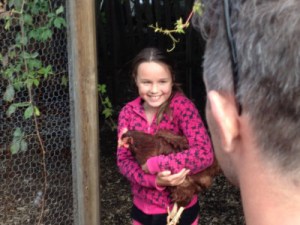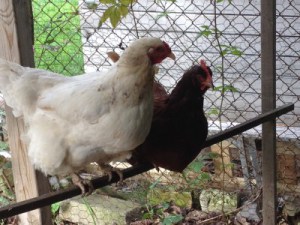Today’s post was written by Sarah Dubé. Sarah is a graduate student pursuing a Master of Planning. She is passionate about food sovereignty and hopes to have an educational permaculture farm someday.
The October 5 workshop presented by the Ecology Action Centre offered an excellent starting point for anyone interested in raising chickens in the city. Upon arriving, it was promising to see such a diverse group of chicken enthusiasts. Av Singh and Louise Hanavan were our experts, and after reviewing chicken basics, we made a pilgrimage to Fred Connors’ backyard. There, we met three hens, and two Muscovy Ducks. Connors’s backyard is un-gated—his flock is occasionally free to wander Bloomfield Street. Chickens are neophobic—they fear anything new. This makes them fairly trustworthy to allow adventuring—but we’re getting ahead of ourselves. Let’s start at the beginning.
 Chickens in the city
Chickens in the city
The Halifax by-law regarding chicken ownership in the city is unclear. There is no formal by-law against raising city chickens, but one would be vulnerable to neighbourhood complaints if hens proved disruptive. About 85% of those surveyed are in favour of backyard chickens—hopefully, those are your neighbours. Generally, the concerns surrounding chickens have to do with: humane treatment, attracting pests, or avian flu… I think it’s safe to say that if you are a responsible chicken-rearer, you need’t worry about such things.
Breeds
Chickens usually live for about 8 to 10 years. As far as eggs go, they are most productive within the first 3 years. A hen will continue to produce eggs beyond that point, but it is at the owner’s discretion to balance the cost of ownership vs. production.
There are many breeds of chicken out there. We discussed meat chickens and dual-purpose chickens. For meat, any breed crossed with Cornish is advised. Dual-purpose chickens include: Rhode Island Red, Arcana, and Barred Rock. This is by no means a comprehensive list. There is a Maritime Heritage Breed registry, if that’s your fancy. There are tons of resources to help you identify just the breed for you.
Laying hens are affected by the seasons. If you want to extend the season, a red light bulb in the coop will assist. A 7-month-old hen will produce pullet egg—a normal egg in every way, miniaturized. If you get a day old chick in the Spring, it will be producing by Fall—and then slowing down. Timing your acquisition may be important, depending on your expectations. It is sometimes possible to acquire an older hen, just check with the suppliers. Some benefits to raising your own chick include the opportunity to grow together, and acclimate. The benefit to an older hen is a big reduction in initial workload.
Housing
Chickens require housing, just like the rest of us. Their house is a coop. A coop is a shelter with perching posts (a roost), nesting boxes, and bedding. Several logistics:
• Perches – should be to scale with your hen. That means: thinner for younger fowl, thicker for mature birds. Out of courtesy, don’t stack perches directly atop of each other—the downstairs hen might have something to say about droppings on her head!
• Nesting box – one nesting box is suitable for up to 3 hens. It should be dark, comfortable, and private. Lined with cozy bedding, the nesting box is where the hen will lay her eggs. You’ll want to check nesting boxes daily, and collect the eggs. If you find an egg, and you’re unsure if it’s old or new, place the egg in water. If it floats, it’s old.
• Bedding – this can be comprised of: woodchips, wood shavings, saw dust, shredded newspaper, straw, etc., and any combination thereof. A deep bedding system can last up to a season. A layer bedding system will need attention every other day, or so. Dry bedding reduces pests, and chances of disease. If a strong odour is present–the coop needs cleaning.
A chicken run provides room for activity and opportunity to participate in natural practices: scratching, foraging, etc. A run should have about 2ft2/hen. The coop should have about 1ft2/hen.
A 200w light bulb can produce an extra boost of heat during the winter months. It’s imperative that drinking water be constantly available—don’t let it freeze!

Nutrition
While on the subject of water, keep water fresh, available, and clean is crucial. There are a few ways to keep water fresh: regular changes, adding 30 ppm hydrogen peroxide, and adding apple cider vinegar to the water (about 1-2%). The apple cider vinegar option is unavailable if using a metal water dispenser.
Chickens need a balanced diet. Grain feed can be supplement in many ways: rejected produce from grocers, kitchen scraps, etc. Many resources are available to outline hens’ preferences and idiosyncrasies, but here are some basics:
Different life stages require different nutrition. A chick needs feed with a 20% protein content, while an 8 month old is comfortable with 16%. There are three main types of food:
1. Chicken Starter – for babies
2. Chicken Grower – for adolescents
3. Layer Mash – for productive adults
Many feeds are available from Homestead Organics. Grain feed is important for intestinal health and helps to prevent parasites.
Feed can be provided freely, but must be complimented by grit. Grit is necessary for digestion. Grit can be sourced by purchasing chicken grit, grinding oyster shells, or allowing access to gravelly terrain. Grit should appear larger than sand, but smaller than a rock; it’s about the size of a small pebble.
Nutritionally, chickens benefit from calcium supplementing. Kelp is an option. Eggshells from production are another option. If opting to recycle eggshells back into your hens diet, it’s important to be meticulous—if a hen recognizes eggshells, she’ll go after fresh eggs.
•Elevating food and water off of the floor helps to reduce pests, and keeps the roost cleaner for longer. First – clean the shells well, and dry thoroughly. This is for disease prevention. Shells can be baked for 10 minutes at 250, or left on a woodstove.
• Second – grind the shells very finely—they shouldn’t be discernible. A really good whirl in the blender is helpful.
Basically, chickens need: (appropriate life stage) grain feed + grit + calcium supplement. Hens don’t tend to eat more than they need–free feeding is suitable.
Health
Following proper housing and nutritional directives are the best means of keeping a hen healthy. As neophobes, however, hens can be stressed. For a healthy hen: don’t stress them out.
Raising chickens provide many benefits. Chickens are entertaining, social, productive creatures. Their waste contributes to amazing compost. It costs about $3.50 (in feed) to produce a dozen organic eggs, compared to over $6.00 retail purchase. When considering raising chickens in your backyard, it is vital to firstly take inventory. Are you ready to take responsibility for the health and welfare of this animal? Chickens are extremely social; you’d never want to get only 1 chicken—3 is generally considered the minimum number. How long will you commit? Will you do what is necessary if your hen suffers from an internal obstruction? An illness? These are just some of the considerations needed before embarking on your chicken journey.



